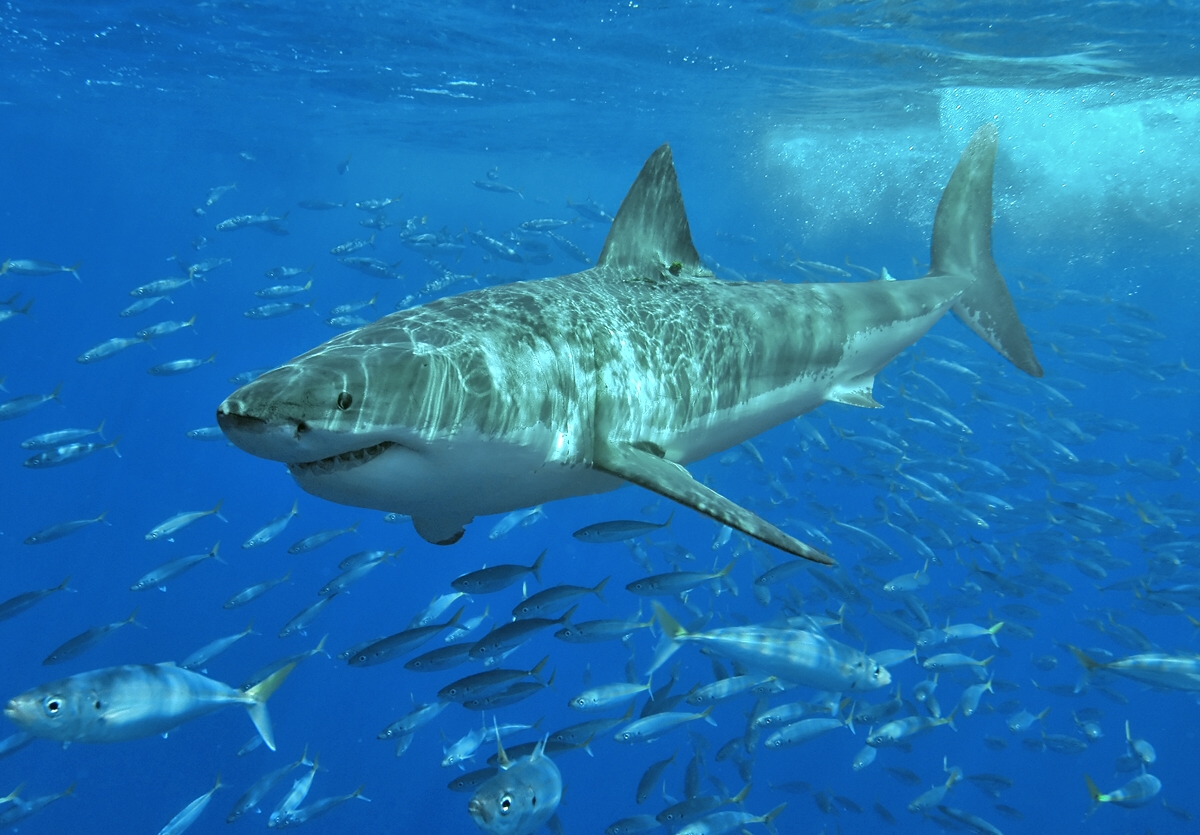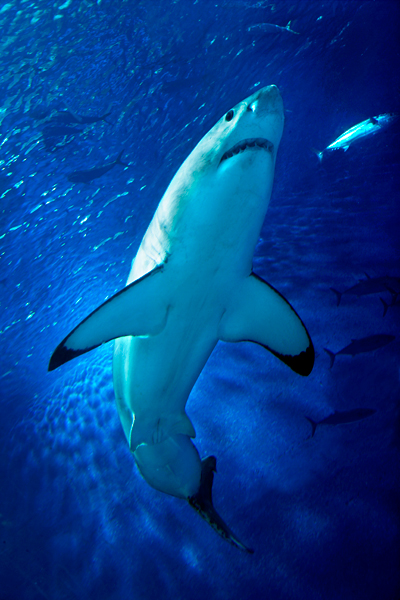Each year, great white sharks migrate over long distances from their feeding grounds off the central California coast to other feeding grounds far away in the Pacific Ocean. They travel as much as 2,500 miles (4,000 km) in an open ocean, where their prey is scarce. If they survived by foraging, sharks would need to work hard in the open ocean to find food. That’s one reason they migrate from one feeding ground to another, to take advantage of the seasonal bounty. But how do they survive the migration to a new feeding ground, across an open ocean that’s almost devoid of their food? Researchers have recently found evidence that great white shark migrations are fueled by large reserves of fat stored in the sharks’ livers.
These findings, reported in the Proceedings of the Royal Society B earlier in 2013 by Gen Del Raye of Hopkins Marine Station and the University of Hawaii and his colleagues, are based on satellite tag data from four great white sharks tagged near the central California coast.
The animation below shows the track of two great white sharks, based on data from satellite tags. The sharks, tagged off the coast of Central California, journeyed through the open ocean, one going to Hawaii and the other to a feeding ground between California and Hawaii.

Blubber, rich in fat, is an important source of energy for many migratory animals during their long migratory journeys. Great white sharks often prey on marine mammals, such as blubber-rich seals and whales, in waters along the coast. But the exact food supply for these sharks during their migrations was not known.
Del Raye and his collaborators hypothesized that migrating great white sharks were tapping into a supply of lipids stored in their liver. Fat is a major component of lipids, a collection of molecules required for cell health and function, especially energy storage. The liver of an adult great white shark accounts for more than a quarter of its body weight. When it’s well stocked in energy reserves, as much as 90% of the liver is taken up by lipids.
Del Raye and his colleagues used tracking data from four great white sharks in the Pacific Ocean to study their location and depth during migration. The four sharks were tagged with two types of data-gathering devices. One is an acoustic tag for tracking local movements within a shark’s foraging area. The other is a pop-up satellite tag that collects information about a shark’s long-distance journeys.
After some period of time, the satellite tag disconnects from the shark, rises to the surface and transmits all the collected data to satellites that forward it to researchers. Satellite tags, which are attached to a shark’s dorsal fin, transmit data such as the shark’s geographic location and depth to satellites that then relay the information to scientists studying the sharks.

Great white sharks move in alternating phases of swimming and drift diving. Drift diving is an energy-saving strategy to travel more distance. When a shark stops swimming, its momentum continues to carry it forward as it drifts downward. The rate of descent during a drift dive depends on the buoyancy of the shark; the higher its buoyancy, the slower its rate of descent.
As it turns out, buoyancy is also an indication of the amount of lipid reserves left in the liver. Since lipids are less dense than water, more lipids in the shark’s body make it more buoyant.
If a great white shark were using lipids to fuel its swimming, as hypothesized by the scientists, the satellite tagging data should show the shark’s rate of descent gradually increasing over its migratory journey. This would indicate that the animal is losing buoyancy, which also means that its supply of liver lipids is decreasing as it gets converted to energy for swimming.
First, however, Del Raye and his team had to figure out how to correlate the rate of descent during drift diving with the shark’s liver lipids reserves. This was done by studying the process in reverse: from late August, 2006 to mid-January, 2007, the team observed the movements of a captive juvenile great white shark at the Monterey Bay Aquarium [ed. note; see image above], recording how the animal’s buoyancy increased as the well-fed shark’s weight increased, indicating that large amounts of fat were being accumulated in its liver.
Observations of the juvenile great white shark’s growth and buoyancy allowed the team to create a model of how the amount of lipids in a great white shark’s liver affected its rate of descent during drift diving. Using this model to analyze the tracking data of the four great white sharks, they were able to see how the sharks were gradually losing buoyancy during the migration as liver lipids were expended to power the shark’s swimming.
In a press release, Barbara Block, professor of marine sciences at the Stanford Woods Institute for the Environment and a member of Del Raye’s team, said:
We have a glimpse now of how white sharks come in from nutrient-poor areas offshore, feed where elephant seal populations are expanding – much like going to an Outback Steakhouse – and store the energy in their livers so they can move offshore again. It helps us understand how important their near-shore habitats are as fueling stations for their entire life history.
By the way, how do scientists tag the sharks? Scientists from Stanford University use a decoy to lure sharks for satellite tagging. In the video below, the two tags used in this study are shown: the acoustic tag for tracking local movements within a foraging area, and the pop-up satellite tag that collects information about the sharks’ long-distance journeys.
Bottom line:
Each year, great white sharks that forage in waters off the central California coast migrate as much as 2,500 miles (4,000 km) over the open ocean, to other feeding grounds in the Pacific Ocean. A team of scientists investigating the tracks of four great white sharks, using data from satellite tags, have found evidence that these long journeys are fueled by lipids, or fat, stored in the sharks’ large livers.











